Scaling Relations of Early-Type Galaxies in MOND
Abstract
1. Introduction
2. MOND and Phantom of RAMSES (PoR)
3. Models
3.1. Luminosities and Surface Brightness
| Model Name | Ellipticity | () | |||||||
|---|---|---|---|---|---|---|---|---|---|
| (1011 ) | (km/s) | (kpc) | (mag arcsec−2) | (mag) | |||||
| M1 (e35 + e35) | 0.17 | 71.55 | 2.65 | 0.27 | 18.14 | −22.53 | −2.8 | 2.43 | 0.07 |
| M2 (e36 + e36) | 0.38 | 103.28 | 2.94 | 0.41 | 17.49 | −23.41 | −3 | 2.37 | 0.02 |
| M3 (e37 + e37) | 0.9 | 139.63 | 3.25 | 0.27 | 16.77 | −24.34 | −3.23 | 2.26 | 0.12 |
| M4 (e38 + e38) | 1.25 | 153.73 | 3.05 | 0.25 | 16.28 | −24.7 | −3.34 | 2.41 | −0.02 |
| M5 (Re36 + Re39) | 0.75 | 163.4 | 2.49 | 0.22 | 16.39 | −24.14 | −3 | 1.66 | −0.06 |
| M6 (Re38 + Re38) | 0.98 | 178.6 | 3.61 | 0.17 | 16.91 | −24.44 | −3.37 | 2.94 | −0.01 |
| e35 | 0.1 | 112.73 | 0.47 | 0.73 | 14.93 | −21.96 | −1.38 | 0.27 | 2.40 |
| e36 | 0.3 | 190.18 | 0.6 | 0.74 | 14.33 | −23.15 | −1.85 | 0.35 | 1.19 |
| e37 | 0.5 | 234.48 | 0.84 | 0.68 | 14.47 | −23.71 | −2.2 | 0.46 | 4.16 |
| e38 | 0.64 | 275.06 | 0.95 | 0.65 | 14.62 | −23.97 | −2.38 | 0.56 | 2.13 |
| e39 | 0.7 | 369.5 | 1.04 | 0.74 | 14.38 | −24.07 | −2.52 | 0.52 | 1.80 |
3.2. Shape in Formation
4. Results
4.1. Ellipticity Relation
4.2. Rotation Parameter
4.3. Isophotal Analysis
4.4. Fundamental Plane
4.5. Effective Phase-Space Density
5. Conclusions
Author Contributions
Funding
Data Availability Statement
Acknowledgments
Conflicts of Interest
References
- Kormendy, J.; Fisher, D.B.; Cornell, M.E.; Bender, R. Structure and Formation of Elliptical and Spheroidal Galaxies. Astrophys. J. Suppl. Ser. 2009, 182, 216–309. [Google Scholar] [CrossRef]
- Emsellem, E.; Cappellari, M.; Krajnović, D.; Alatalo, K.; Blitz, L.; Bois, M.; Bournaud, F.; Bureau, M.; Davies, R.L.; Davis, T.A.; et al. The ATLAS3D project—III. A census of the stellar angular momentum within the effective radius of early-type galaxies: Unveiling the distribution of fast and slow rotators. Mon. Not. R. Astron. Soc. 2011, 414, 888–912. [Google Scholar] [CrossRef]
- Cappellari, M.; Emsellem, E.; Krajnović, D.; McDermid, R.M.; Scott, N.; Verdoes Kleijn, G.A.; Young, L.M.; Alatalo, K.; Bacon, R.; Blitz, L.; et al. The ATLAS3D project—I. A volume-limited sample of 260 nearby early-type galaxies: Science goals and selection criteria. Mon. Not. R. Astron. Soc. 2011, 413, 813–836. [Google Scholar] [CrossRef]
- Dressler, A. Galaxy morphology in rich clusters: Implications for the formation and evolution of galaxies. Astrophys. J. 1980, 236, 351–365. [Google Scholar] [CrossRef]
- Whitmore, B.C.; Gilmore, D.M.; Jones, C. What Determines the Morphological Fractions in Clusters of Galaxies? Astrophys. J. 1993, 407, 489. [Google Scholar] [CrossRef]
- Trujillo, I.; Conselice, C.J.; Bundy, K.; Cooper, M.C.; Eisenhardt, P.; Ellis, R.S. Strong size evolution of the most massive galaxies since z ∼ 2. Mon. Not. R. Astron. Soc. 2007, 382, 109–120. [Google Scholar] [CrossRef]
- Kriek, M.; van Dokkum, P.G.; Labbé, I.; Franx, M.; Illingworth, G.D.; Marchesini, D.; Quadri, R.F. An Ultra-Deep Near-Infrared Spectrum of a Compact Quiescent Galaxy at z = 2.2. Astrophys. J. 2009, 700, 221–231. [Google Scholar] [CrossRef]
- Haslbauer, M.; Kroupa, P.; Zonoozi, A.H.; Haghi, H. Has JWST Already Falsified Dark-matter-driven Galaxy Formation? Astrophys. J. Lett. 2022, 939, L31. [Google Scholar] [CrossRef]
- Donnan, C.T.; McLeod, D.J.; Dunlop, J.S.; McLure, R.J.; Carnall, A.C.; Begley, R.; Cullen, F.; Hamadouche, M.L.; Bowler, R.A.A.; Magee, D.; et al. The evolution of the galaxy UV luminosity function at redshifts z ≃ 8–15 from deep JWST and ground-based near-infrared imaging. Mon. Not. R. Astron. Soc. 2023, 518, 6011–6040. [Google Scholar] [CrossRef]
- Harikane, Y.; Ouchi, M.; Oguri, M.; Ono, Y.; Nakajima, K.; Isobe, Y.; Umeda, H.; Mawatari, K.; Zhang, Y. A Comprehensive Study of Galaxies at z 9–16 Found in the Early JWST Data: Ultraviolet Luminosity Functions and Cosmic Star Formation History at the Pre-reionization Epoch. Astrophys. J. Suppl. Ser. 2023, 265, 5. [Google Scholar] [CrossRef]
- Harikane, Y.; Nakajima, K.; Ouchi, M.; Umeda, H.; Isobe, Y.; Ono, Y.; Xu, Y.; Zhang, Y. Pure Spectroscopic Constraints on UV Luminosity Functions and Cosmic Star Formation History from 25 Galaxies at zspec = 8.61–13.20 Confirmed with JWST/NIRSpec. Astrophys. J. 2024, 960, 56. [Google Scholar] [CrossRef]
- Djorgovski, S.; Davis, M. Fundamental Properties of Elliptical Galaxies. Astrophys. J. 1987, 313, 59. [Google Scholar] [CrossRef]
- Binney, J. On the rotation of elliptical galaxies. Mon. Not. R. Astron. Soc. 1978, 183, 501–514. [Google Scholar] [CrossRef]
- Kormendy, J. Brightness distributions in compact and normal galaxies. II. Structure parameters of the spheroidal component. Astrophys. J. 1977, 218, 333–346. [Google Scholar] [CrossRef]
- Springel, V.; White, S.D.M.; Jenkins, A.; Frenk, C.S.; Yoshida, N.; Gao, L.; Navarro, J.; Thacker, R.; Croton, D.; Helly, J.; et al. Simulations of the formation, evolution and clustering of galaxies and quasars. Nature 2005, 435, 629–636. [Google Scholar] [CrossRef]
- Schaye, J.; Crain, R.A.; Bower, R.G.; Furlong, M.; Schaller, M.; Theuns, T.; Dalla Vecchia, C.; Frenk, C.S.; McCarthy, I.G.; Helly, J.C.; et al. The EAGLE project: Simulating the evolution and assembly of galaxies and their environments. Mon. Not. R. Astron. Soc. 2015, 446, 521–554. [Google Scholar] [CrossRef]
- Pillepich, A.; Springel, V.; Nelson, D.; Genel, S.; Naiman, J.; Pakmor, R.; Hernquist, L.; Torrey, P.; Vogelsberger, M.; Weinberger, R.; et al. Simulating galaxy formation with the IllustrisTNG model. Mon. Not. R. Astron. Soc. 2018, 473, 4077–4106. [Google Scholar] [CrossRef]
- Kroupa, P. The Dark Matter Crisis: Falsification of the Current Standard Model of Cosmology. Publ. Astron. Soc. Aust. 2012, 29, 395–433. [Google Scholar] [CrossRef]
- Kroupa, P. Galaxies as simple dynamical systems: Observational data disfavor dark matter and stochastic star formation. Can. J. Phys. 2015, 93, 169–202. [Google Scholar] [CrossRef]
- Banik, I.; Zhao, H. From Galactic Bars to the Hubble Tension: Weighing Up the Astrophysical Evidence for Milgromian Gravity. Symmetry 2022, 14, 1331. [Google Scholar] [CrossRef]
- Melia, F. A Candid Assessment of Standard Cosmology. Publ. Astron. Soc. Pac. 2022, 134, 121001. [Google Scholar] [CrossRef]
- Kroupa, P.; Gjergo, E.; Asencio, E.; Haslbauer, M.; Pflamm-Altenburg, J.; Wittenburg, N.; Samaras, N.; Thies, I.; Oehm, W. The many tensions with dark-matter based models and implications on the nature of the Universe. arXiv 2023, arXiv:2309.11552. [Google Scholar] [CrossRef]
- Eappen, R.; Kroupa, P.; Wittenburg, N.; Haslbauer, M.; Famaey, B. The formation of early-type galaxies through monolithic collapse of gas clouds in Milgromian gravity. Mon. Not. R. Astron. Soc. 2022, 516, 1081–1093. [Google Scholar] [CrossRef]
- Katz, H.; McGaugh, S.; Teuben, P.; Angus, G.W. Galaxy Cluster Bulk Flows and Collision Velocities in QUMOND. Astrophys. J. 2013, 772, 10. [Google Scholar] [CrossRef]
- Wittenburg, N.; Kroupa, P.; Banik, I.; Candlish, G.; Samaras, N. Hydrodynamical structure formation in Milgromian cosmology. Mon. Not. R. Astron. Soc. 2023, 523, 453–473. [Google Scholar] [CrossRef]
- McGaugh, S.S. Discord in Concordance Cosmology and Anomalously Massive Early Galaxies. Universe 2024, 10, 48. [Google Scholar] [CrossRef]
- Milgrom, M. A modification of the Newtonian dynamics as a possible alternative to the hidden mass hypothesis. Astrophys. J. 1983, 270, 365–370. [Google Scholar] [CrossRef]
- Famaey, B.; McGaugh, S.S. Modified Newtonian Dynamics (MOND): Observational Phenomenology and Relativistic Extensions. Living Rev. Relativ. 2012, 15, 10. [Google Scholar] [CrossRef]
- Famaey, B.; Durakovic, A. Modified Newtonian Dynamics (MOND). arXi 2025, arXiv:2501.17006. [Google Scholar] [CrossRef]
- Bekenstein, J.; Milgrom, M. Does the missing mass problem signal the breakdown of Newtonian gravity? Astrophys. J. 1984, 286, 7–14. [Google Scholar] [CrossRef]
- Milgrom, M. Quasi-linear formulation of MOND. Mon. Not. R. Astron. Soc. 2010, 403, 886–895. [Google Scholar] [CrossRef]
- Milgrom, M. The MOND paradigm. arXiv 2008, arXiv:0801.3133. [Google Scholar]
- Milgrom, M. The MOND paradigm of modified dynamics. Scholarpedia 2014, 9, 31410. [Google Scholar] [CrossRef]
- McGaugh, S.S.; Schombert, J.M.; Bothun, G.D.; de Blok, W.J.G. The Baryonic Tully-Fisher Relation. Astrophys. J. 2000, 533, L99–L102. [Google Scholar] [CrossRef] [PubMed]
- McGaugh, S.S. The Baryonic Tully-Fisher Relation of Galaxies with Extended Rotation Curves and the Stellar Mass of Rotating Galaxies. Astrophys. J. 2005, 632, 859–871. [Google Scholar] [CrossRef]
- McGaugh, S.S. The Baryonic Tully-Fisher Relation of Gas-rich Galaxies as a Test of ΛCDM and MOND. Astron. J. 2012, 143, 40. [Google Scholar] [CrossRef]
- Liu, Y.; Peng, E.W.; Blakeslee, J.; Côté, P.; Ferrarese, L.; Jordán, A.; Puzia, T.H.; Toloba, E.; Zhang, H.X. Evidence for the Rapid Formation of Low-mass Early-type Galaxies in Dense Environments. Astrophys. J. 2016, 818, 179. [Google Scholar] [CrossRef]
- Sanders, R.H. Mass discrepancies in galaxies: Dark matter and alternatives. Astron. Astrophys. Rev. 1990, 2, 1–28. [Google Scholar] [CrossRef]
- McGaugh, S.S. The Mass Discrepancy-Acceleration Relation: Disk Mass and the Dark Matter Distribution. Astrophys. J. 2004, 609, 652–666. [Google Scholar] [CrossRef]
- Lelli, F.; McGaugh, S.S.; Schombert, J.M.; Pawlowski, M.S. One Law to Rule Them All: The Radial Acceleration Relation of Galaxies. Astrophys. J. 2017, 836, 152. [Google Scholar] [CrossRef]
- Lüghausen, F.; Famaey, B.; Kroupa, P. Phantom of RAMSES (POR): A new Milgromian dynamics N-body code. Can. J. Phys. 2015, 93, 232–241. [Google Scholar] [CrossRef]
- Nagesh, S.T.; Banik, I.; Thies, I.; Kroupa, P.; Famaey, B.; Wittenburg, N.; Parziale, R.; Haslbauer, M. The Phantom of RAMSES user guide for galaxy simulations using Milgromian and Newtonian gravity. Can. J. Phys. 2021, 99, 607–613. [Google Scholar] [CrossRef]
- Teyssier, R. Cosmological hydrodynamics with adaptive mesh refinement. A new high resolution code called RAMSES. Astron. Astrophys. A A 2002, 385, 337–364. [Google Scholar] [CrossRef]
- Renaud, F.; Famaey, B.; Kroupa, P. Star formation triggered by galaxy interactions in modified gravity. Mon. Not. R. Astron. Soc. 2016, 463, 3637–3652. [Google Scholar] [CrossRef]
- Thomas, G.F.; Famaey, B.; Ibata, R.; Lüghausen, F.; Kroupa, P. Stellar streams as gravitational experiments. I. The case of Sagittarius. Astron. Astrophys. A A 2017, 603, A65. [Google Scholar] [CrossRef]
- Bílek, M.; Thies, I.; Kroupa, P.; Famaey, B. MOND simulation suggests an origin for some peculiarities in the Local Group. Astron. Astrophys. A A 2018, 614, A59. [Google Scholar] [CrossRef]
- Banik, I.; O’Ryan, D.; Zhao, H. Origin of the Local Group satellite planes. Mon. Not. R. Astron. Soc. 2018, 477, 4768–4791. [Google Scholar] [CrossRef]
- Bílek, M.; Thies, I.; Kroupa, P.; Famaey, B. Are Disks of Satellites Comprised of Tidal Dwarf Galaxies? Galaxies 2021, 9, 100. [Google Scholar] [CrossRef]
- Thomas, G.F.; Famaey, B.; Ibata, R.; Renaud, F.; Martin, N.F.; Kroupa, P. Stellar streams as gravitational experiments. II. Asymmetric tails of globular cluster streams. Astron. Astrophys. A A 2018, 609, A44. [Google Scholar] [CrossRef]
- Kroupa, P.; Jerabkova, T.; Thies, I.; Pflamm-Altenburg, J.; Famaey, B.; Boffin, H.M.J.; Dabringhausen, J.; Beccari, G.; Prusti, T.; Boily, C.; et al. Asymmetrical tidal tails of open star clusters: Stars crossing their cluster’s práh challenge Newtonian gravitation. Mon. Not. R. Astron. Soc. 2022, 517, 3613–3639. [Google Scholar] [CrossRef]
- Wittenburg, N.; Kroupa, P.; Famaey, B. The Formation of Exponential Disk Galaxies in MOND. Astrophys. J. 2020, 890, 173. [Google Scholar] [CrossRef]
- Banik, I.; Thies, I.; Famaey, B.; Candlish, G.; Kroupa, P.; Ibata, R. The Global Stability of M33 in MOND. Astrophys. J. 2020, 905, 135. [Google Scholar] [CrossRef]
- Bílek, M.; Zhao, H.; Famaey, B.; Müller, O.; Kroupa, P.; Ibata, R. Evolution of globular-cluster systems of ultra-diffuse galaxies due to dynamical friction in MOND gravity. Astron. Astrophys. A A 2021, 653, A170. [Google Scholar] [CrossRef]
- Lüghausen, F.; Famaey, B.; Kroupa, P.; Angus, G.; Combes, F.; Gentile, G.; Tiret, O.; Zhao, H. Polar ring galaxies as tests of gravity. Mon. Not. R. Astron. Soc. 2013, 432, 2846–2853. [Google Scholar] [CrossRef]
- Eappen, R.; Kroupa, P. The formation of compact massive relic galaxies in MOND. Mon. Not. R. Astron. Soc. 2024, 528, 4264–4271. [Google Scholar] [CrossRef]
- Tauber, J. et al. [Planck Collaboration]; Aghanim, N.; Akrami, Y.; Ashdown, M.; Aumont, J.; Baccigalupi, C.; Ballardini, M.; Banday, A.J.; Barreiro, R.B.; Bartolo, N.; et al. Planck 2018 results. VI. Cosmological parameters. Astron. Astrophys. A A 2020, 641, A6. [Google Scholar] [CrossRef]
- Thomas, D.; Maraston, C.; Schawinski, K.; Sarzi, M.; Silk, J. Environment and self-regulation in galaxy formation. Mon. Not. R. Astron. Soc. 2010, 404, 1775–1789. [Google Scholar] [CrossRef]
- Bell, E.F.; de Jong, R.S. Stellar Mass-to-Light Ratios and the Tully-Fisher Relation. Astrophys. J. 2001, 550, 212–229. [Google Scholar] [CrossRef]
- Bell, E.F.; McIntosh, D.H.; Katz, N.; Weinberg, M.D. The Optical and Near-Infrared Properties of Galaxies. I. Luminosity and Stellar Mass Functions. Astrophys. J. Suppl. Ser. 2003, 149, 289–312. [Google Scholar] [CrossRef]
- Cappellari, M.; Bacon, R.; Bureau, M.; Damen, M.C.; Davies, R.L.; de Zeeuw, P.T.; Emsellem, E.; Falcón-Barroso, J.; Krajnović, D.; Kuntschner, H.; et al. The SAURON project—IV. The mass-to-light ratio, the virial mass estimator and the Fundamental Plane of elliptical and lenticular galaxies. Mon. Not. R. Astron. Soc. 2006, 366, 1126–1150. [Google Scholar] [CrossRef]
- Kroupa, P.; Gjergo, E.; Jerabkova, T.; Yan, Z. The initial mass function of stars. arXiv 2024, arXiv:2410.07311. [Google Scholar] [CrossRef]
- Mo, H.; van den Bosch, F.C.; White, S. Galaxy Formation and Evolution; Cambridge University Press: Cambridge, UK, 2010. [Google Scholar]
- Binney, J.; Tremaine, S. Galactic Dynamics, 2nd ed.; Princeton University Press: Princeton, NJ, USA, 2008. [Google Scholar]
- Cassata, P.; Giavalisco, M.; Guo, Y.; Renzini, A.; Ferguson, H.; Koekemoer, A.M.; Salimbeni, S.; Scarlata, C.; Grogin, N.A.; Conselice, C.J.; et al. The Relative Abundance of Compact and Normal Massive Early-type Galaxies and Its Evolution from Redshift z ~2 to the Present. Astrophys. J. 2011, 743, 96. [Google Scholar] [CrossRef]
- Dabringhausen, J.; Fellhauer, M. An extensive catalogue of early-type galaxies in the nearby Universe. Mon. Not. R. Astron. Soc. 2016, 460, 4492–4512. [Google Scholar] [CrossRef]
- Davies, R.L.; Efstathiou, G.; Fall, S.M.; Illingworth, G.; Schechter, P.L. The kinematic properties of faint elliptical galaxies. Astrophys. J. 1983, 266, 41–57. [Google Scholar] [CrossRef]
- Halliday, C.; Davies, R.L.; Kuntschner, H.; Birkinshaw, M.; Bender, R.; Saglia, R.P.; Baggley, G. Line-of-sight velocity distributions of low-luminosity elliptical galaxies. Mon. Not. R. Astron. Soc. 2001, 326, 473–489. [Google Scholar] [CrossRef]
- Rothberg, B.; Joseph, R.D. A Survey of Merger Remnants. II. The Emerging Kinematic and Photometric Correlations. Astron. J. 2006, 131, 185–207. [Google Scholar] [CrossRef]
- Emsellem, E.; Cappellari, M.; Krajnović, D.; van de Ven, G.; Bacon, R.; Bureau, M.; Davies, R.L.; de Zeeuw, P.T.; Falcón-Barroso, J.; Kuntschner, H.; et al. The SAURON project—IX. A kinematic classification for early-type galaxies. Mon. Not. R. Astron. Soc. 2007, 379, 401–417. [Google Scholar] [CrossRef]
- Meza, A.; Navarro, J.F.; Steinmetz, M.; Eke, V.R. Simulations of Galaxy Formation in a ΛCDM Universe. III. The Dissipative Formation of an Elliptical Galaxy. Astrophys. J. 2003, 590, 619–635. [Google Scholar] [CrossRef]
- Binney, J.; Tremaine, S. Galactic Dynamics; Princeton University Press: Princeton, NJ, USA, 1987. [Google Scholar]
- Bender, R.; Doebereiner, S.; Moellenhoff, C. Isophote shapes of elliptical galaxies. I. The data. Astron. Astrophys. Suppl. Ser. 1988, 74, 385–426. [Google Scholar]
- Dressler, A.; Lynden-Bell, D.; Burstein, D.; Davies, R.L.; Faber, S.M.; Terlevich, R.; Wegner, G. Spectroscopy and Photometry of Elliptical Galaxies. I. New Distance Estimator. Astrophys. J. 1987, 313, 42. [Google Scholar] [CrossRef]
- Bender, R.; Burstein, D.; Faber, S.M. Dynamically Hot Galaxies. I. Structural Properties. Astrophys. J. 1992, 399, 462. [Google Scholar] [CrossRef]
- Pahre, M.A. Near-infrared Imaging of Early-Type Galaxies. II. Global Photometric Parameters. Astrophys. J. Suppl. Ser. 1999, 124, 127–169. [Google Scholar] [CrossRef]
- Pahre, M.A.; de Carvalho, R.R.; Djorgovski, S.G. Near-Infrared Imaging of Early-Type Galaxies. IV. The Physical Origins of the Fundamental Plane Scaling Relations. Astron. J. 1998, 116, 1606–1625. [Google Scholar] [CrossRef]
- Masjedi, M.; Hogg, D.W.; Blanton, M.R. The Growth of Luminous Red Galaxies by Merging. Astrophys. J. 2008, 679, 260–268. [Google Scholar] [CrossRef]
- Delgado-Serrano, R.; Hammer, F.; Yang, Y.B.; Puech, M.; Flores, H.; Rodrigues, M. How was the Hubble sequence 6 Gyr ago? Astron. Astrophys. A A 2010, 509, A78. [Google Scholar] [CrossRef]
- Kroupa, P.; Subr, L.; Jerabkova, T.; Wang, L. Very high redshift quasars and the rapid emergence of supermassive black holes. Mon. Not. R. Astron. Soc. 2020, 498, 5652–5683. [Google Scholar] [CrossRef]
- Xu, Y.; Ouchi, M.; Yajima, H.; Fukushima, H.; Harikane, Y.; Isobe, Y.; Nakajima, K.; Nakane, M.; Ono, Y.; Umeda, H.; et al. Dynamics of GN-z11 Explored by JWST Integral Field Spectroscopy: Gaseous Rotating Disk at z = 10.60 Suggestive of Weak Feedback? arXiv 2024, arXiv:2404.16963. [Google Scholar] [CrossRef]
- Pipino, A.; Matteucci, F. Are dry mergers of ellipticals the way to reconcile model predictions with downsizing? Astron. Astrophys. A A 2008, 486, 763–769. [Google Scholar] [CrossRef]
- Krajnović, D.; Emsellem, E.; Cappellari, M.; Alatalo, K.; Blitz, L.; Bois, M.; Bournaud, F.; Bureau, M.; Davies, R.L.; Davis, T.A.; et al. The ATLAS3D project—II. Morphologies, kinemetric features and alignment between photometric and kinematic axes of early-type galaxies. Mon. Not. R. Astron. Soc. 2011, 414, 2923–2949. [Google Scholar] [CrossRef]
- Yıldırım, A.; van den Bosch, R.C.E.; van de Ven, G.; Martín-Navarro, I.; Walsh, J.L.; Husemann, B.; Gültekin, K.; Gebhardt, K. The structural and dynamical properties of compact elliptical galaxies. Mon. Not. R. Astron. Soc. 2017, 468, 4216–4245. [Google Scholar] [CrossRef]
- Sanders, R.H. Cosmology with modified Newtonian dynamics (MOND). Mon. Not. R. Astron. Soc. 1998, 296, 1009–1018. [Google Scholar] [CrossRef]
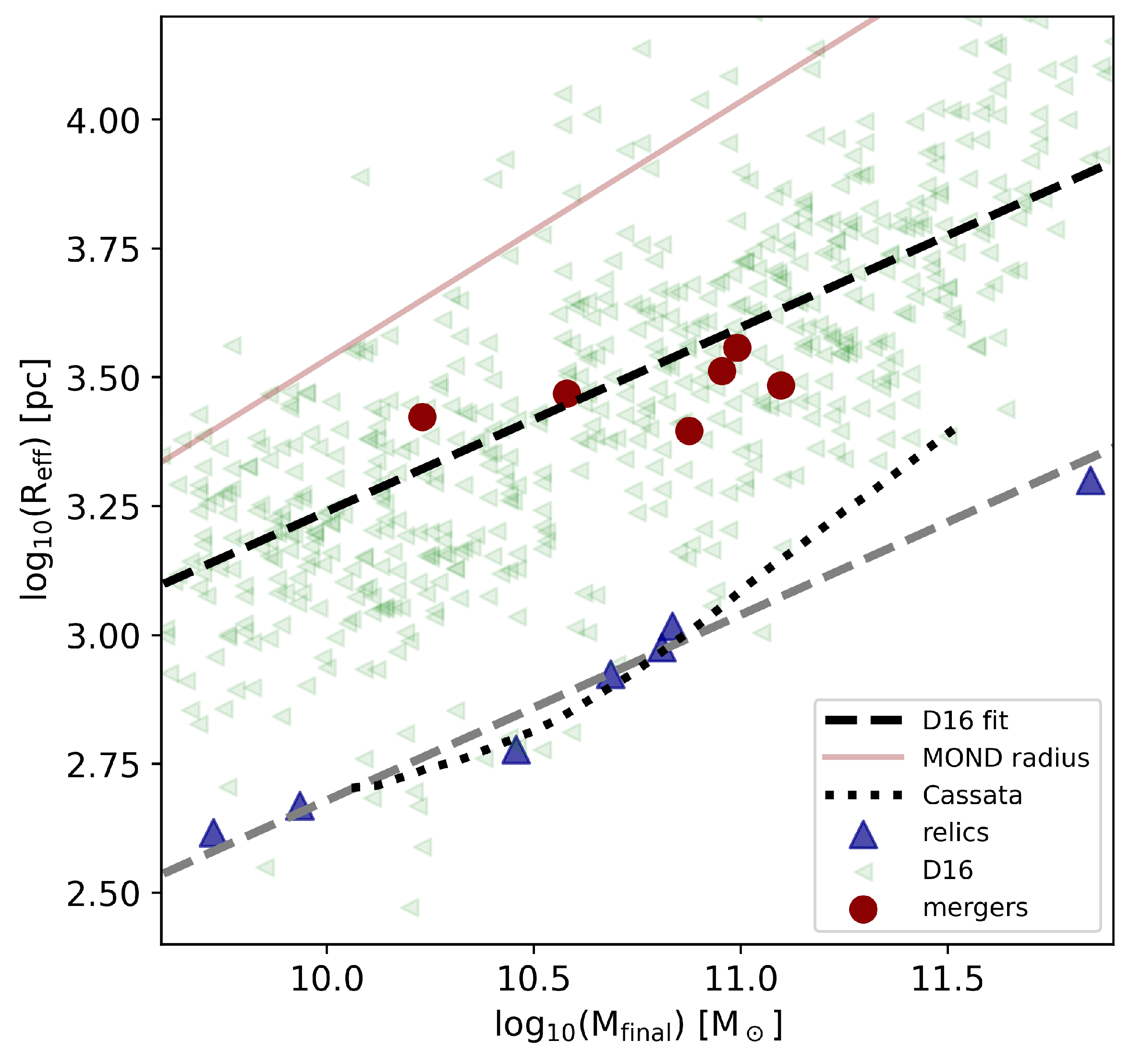
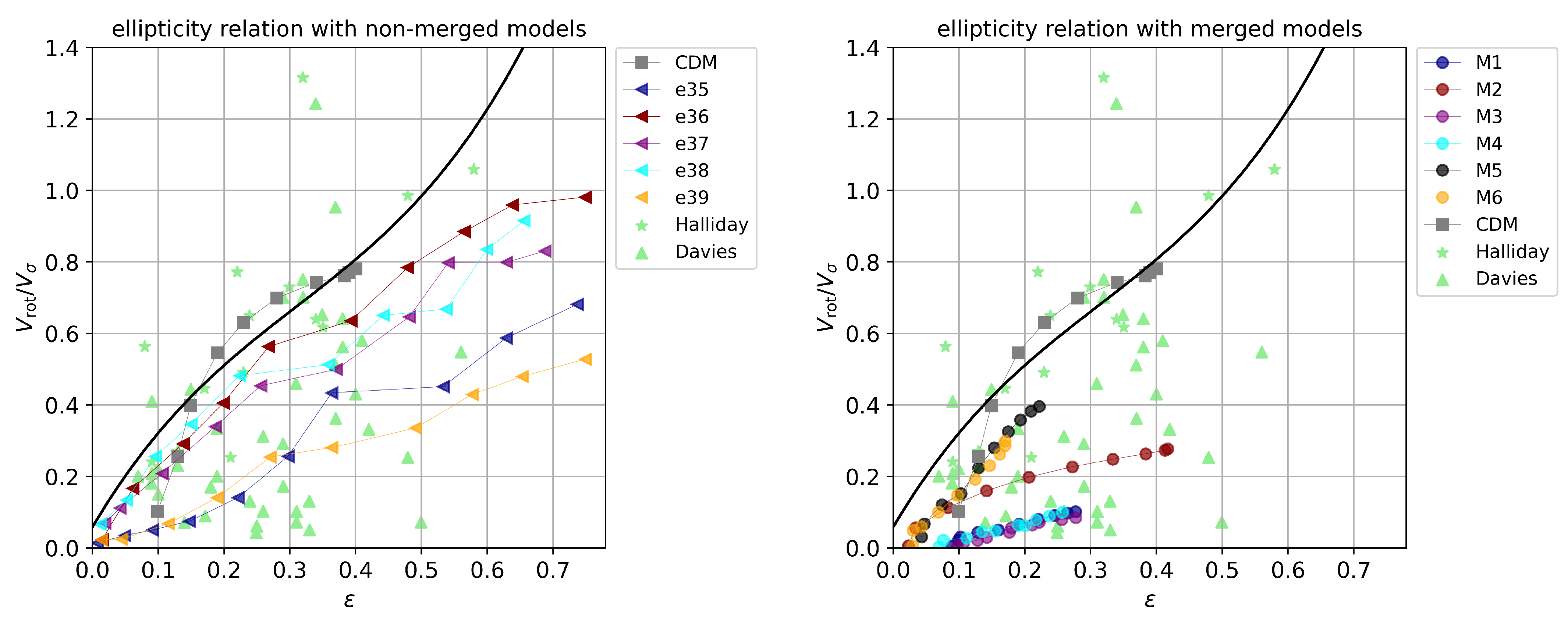
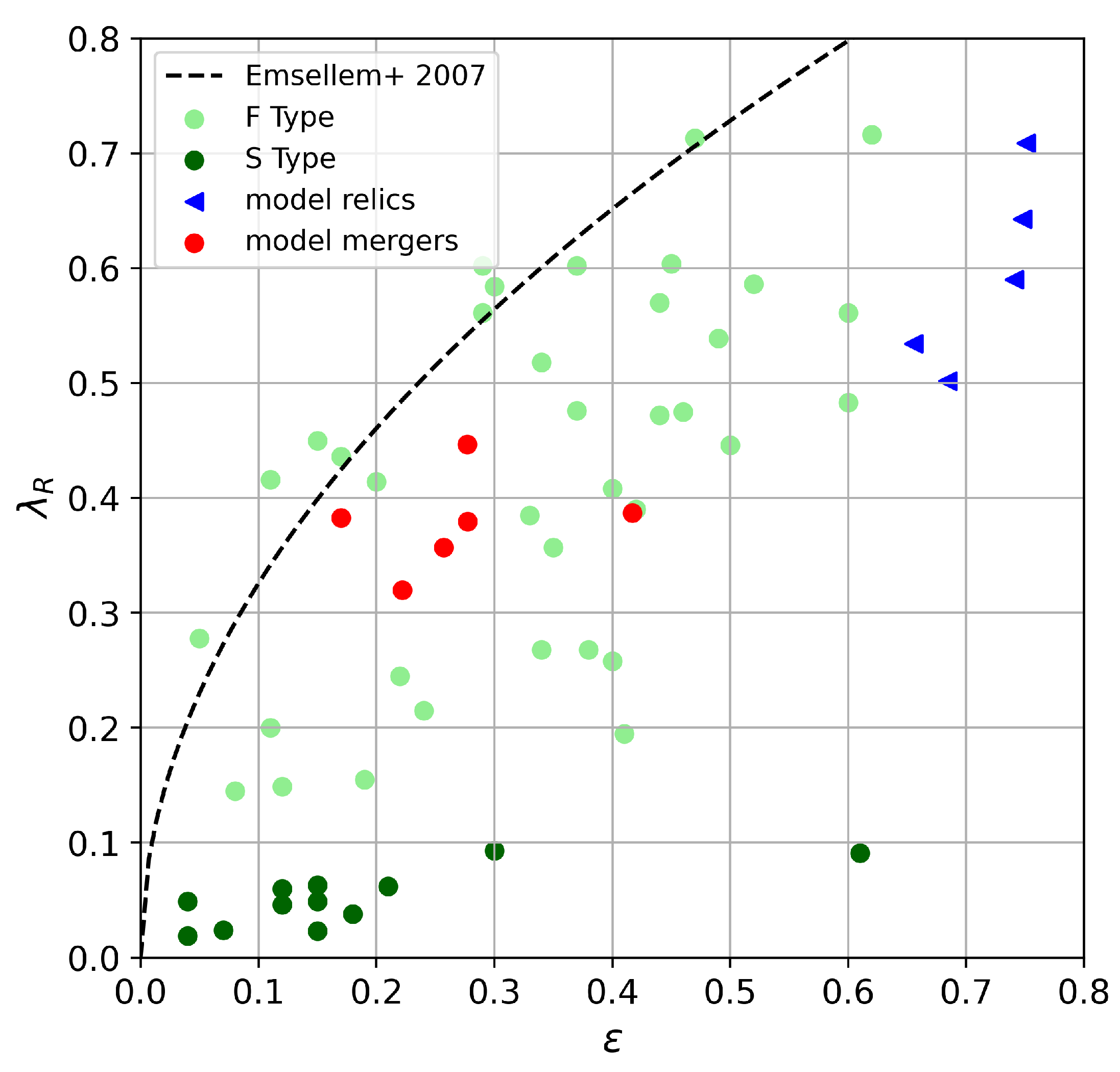

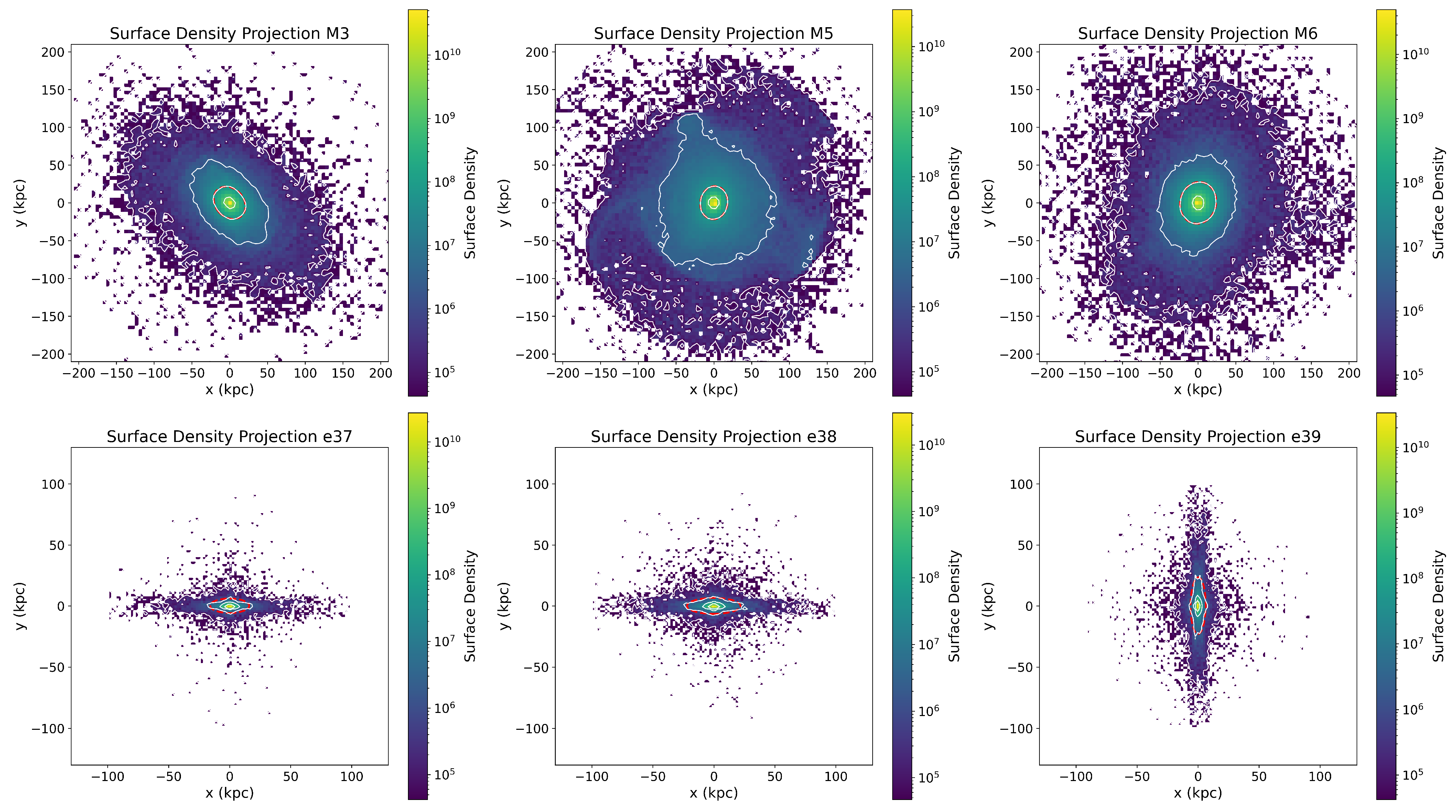
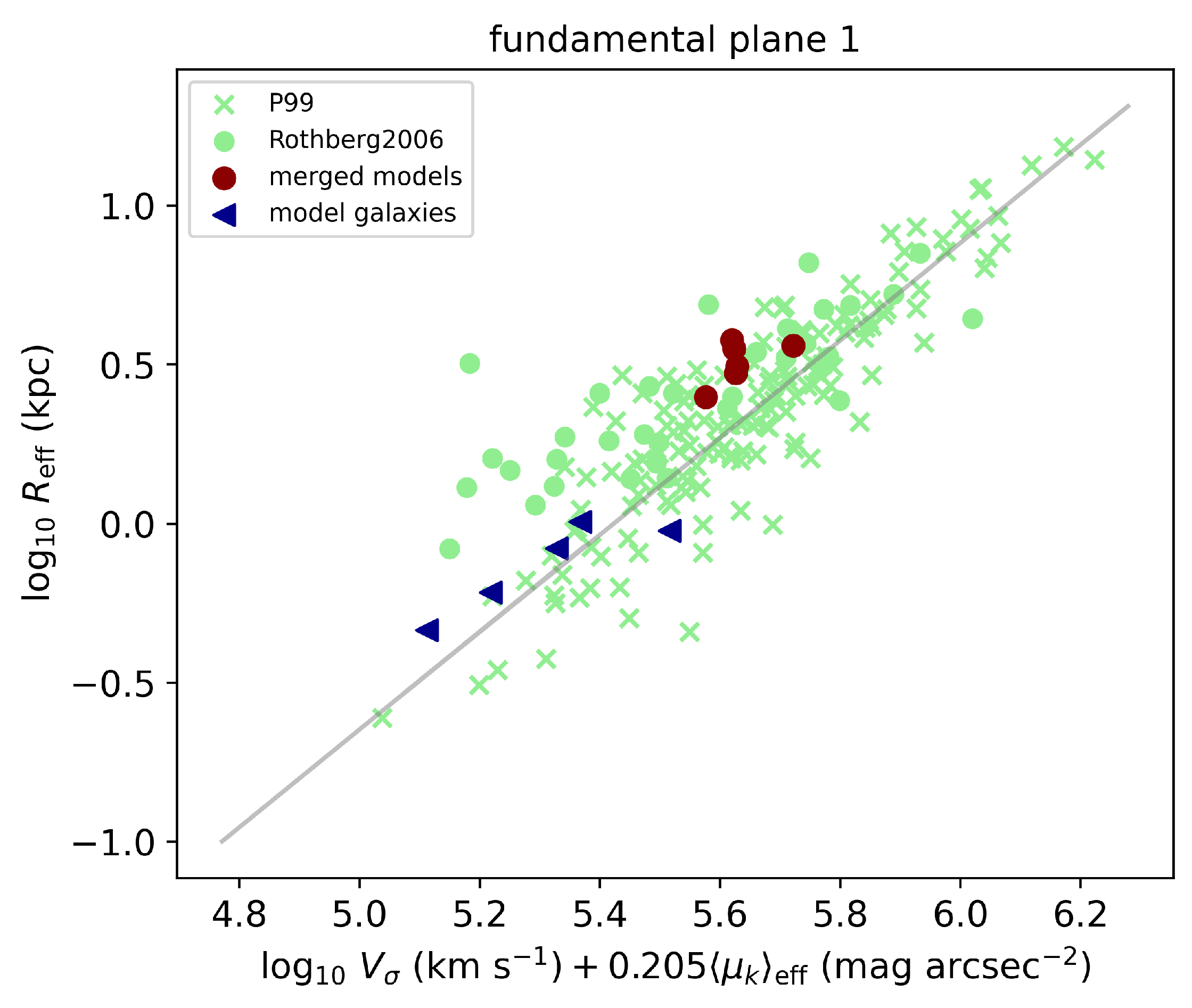

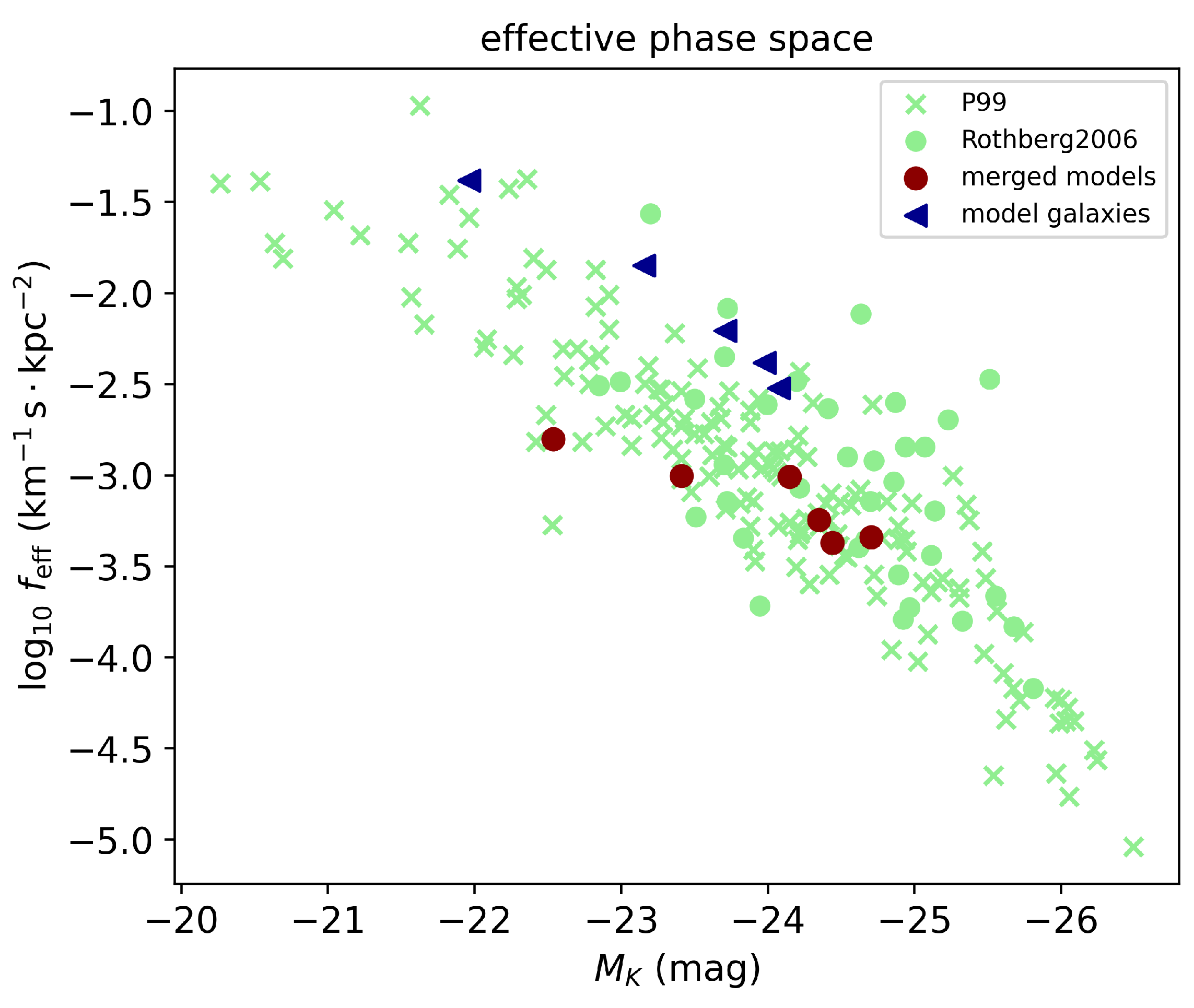
Disclaimer/Publisher’s Note: The statements, opinions and data contained in all publications are solely those of the individual author(s) and contributor(s) and not of MDPI and/or the editor(s). MDPI and/or the editor(s) disclaim responsibility for any injury to people or property resulting from any ideas, methods, instructions or products referred to in the content. |
© 2025 by the authors. Licensee MDPI, Basel, Switzerland. This article is an open access article distributed under the terms and conditions of the Creative Commons Attribution (CC BY) license (https://creativecommons.org/licenses/by/4.0/).
Share and Cite
Eappen, R.; Kroupa, P. Scaling Relations of Early-Type Galaxies in MOND. Galaxies 2025, 13, 22. https://doi.org/10.3390/galaxies13020022
Eappen R, Kroupa P. Scaling Relations of Early-Type Galaxies in MOND. Galaxies. 2025; 13(2):22. https://doi.org/10.3390/galaxies13020022
Chicago/Turabian StyleEappen, Robin, and Pavel Kroupa. 2025. "Scaling Relations of Early-Type Galaxies in MOND" Galaxies 13, no. 2: 22. https://doi.org/10.3390/galaxies13020022
APA StyleEappen, R., & Kroupa, P. (2025). Scaling Relations of Early-Type Galaxies in MOND. Galaxies, 13(2), 22. https://doi.org/10.3390/galaxies13020022






